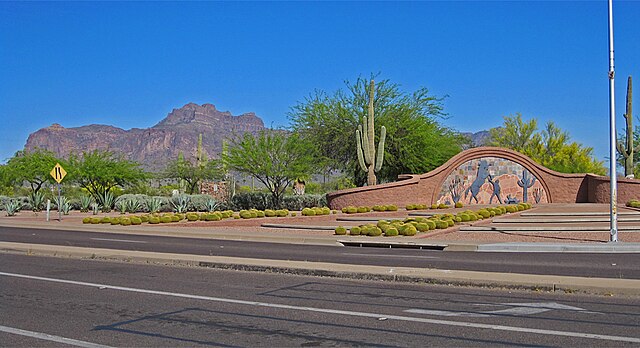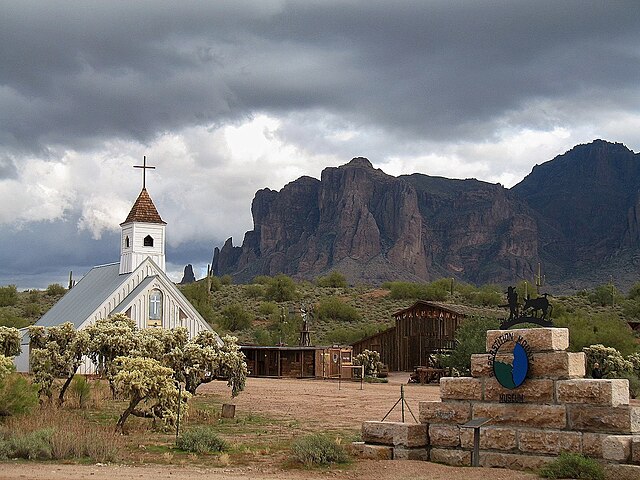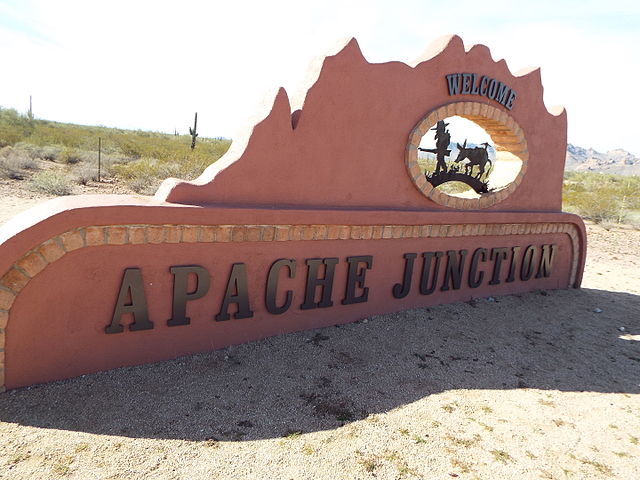Have you ever wondered what it’s like to live where the desert meets the mountains, where Old West legends come alive, and where modern amenities blend seamlessly with rugged natural beauty? Welcome to Apache Junction, Arizona – a city that’s been quietly capturing hearts and imaginations for decades.
Nestled at the base of the legendary Superstition Mountains, Apache Junction isn’t just another desert town. It’s a place where treasure hunters still search for the Lost Dutchman’s gold, where retirees find their perfect winter retreat, and where adventure seekers discover some of Arizona’s most spectacular outdoor experiences. But what really makes this city tick, and why should you care about this seemingly small desert community?
What Makes Apache Junction Special?
Apache Junction stands out like a diamond in the rough of Arizona’s Sonoran Desert. Unlike the bustling metropolis of Phoenix just 40 miles away, this city maintains a small-town charm while offering big-city conveniences. It’s the kind of place where you can hike world-class trails in the morning and enjoy a craft beer at a local brewery in the evening.
Location and Geography
Strategically positioned in Pinal County, Apache Junction sits at the crossroads of adventure and accessibility. The city occupies about 35 square miles of high Sonoran Desert, with elevations ranging from 1,500 to 2,000 feet above sea level. This elevation gives it a slightly cooler climate than the Phoenix valley floor, making it particularly attractive to those seeking desert living without the extreme heat.
The Superstition Mountains form a dramatic backdrop to the north and east, creating one of the most photographed skylines in Arizona. These aren’t just pretty rocks – they’re home to countless hiking trails, hidden canyons, and yes, legendary treasure tales that continue to draw explorers from around the world.
The Story Behind the Name
Ever curious about how places get their names? Apache Junction’s moniker comes from its location at the junction of the Apache Trail (State Route 88) and U.S. Highway 60. The Apache Trail itself was named after the Native American tribes who once traveled these ancient paths through the desert. It’s a name that perfectly captures the area’s rich indigenous history and its role as a crossroads of cultures and commerce.
A Brief History of Apache Junction
From Mining Town to Modern City
Apache Junction’s story reads like a classic Western novel. The area’s history stretches back centuries, with Native American tribes calling this desert home long before European settlers arrived. The modern story begins in the late 1800s when prospectors and miners flocked to the Superstition Mountains, drawn by rumors of gold and silver.
The city we know today didn’t officially incorporate until 1978, making it relatively young by Arizona standards. Before incorporation, it was a collection of small communities, trailer parks, and desert homesteads. The transformation from a loose collection of desert dwellers to a proper city happened gradually, driven by retirees seeking warm winters and outdoor enthusiasts drawn to the incredible natural playground.
The Role of the Superstition Mountains
You can’t talk about Apache Junction without mentioning the Superstition Mountains. These peaks aren’t just scenery – they’re the heart and soul of the community. The mountains have shaped everything from the city’s economy to its culture. They’re the reason people come here, the backdrop for countless photographs, and the source of legends that have captivated imaginations for generations.
The most famous of these legends is the Lost Dutchman’s Gold Mine, allegedly discovered by Jacob Waltz in the 1870s. While treasure hunters still search for this elusive mine, the real treasure might just be the incredible hiking, rock climbing, and outdoor adventures the mountains provide year-round.
Top Attractions and Things to Do

Superstition Mountain Museum
Step into the Wild West at the Superstition Mountain Museum, where Apache Junction’s colorful past comes alive. This isn’t your typical stuffy museum – it’s an immersive experience that tells the story of the American Southwest through authentic artifacts, interactive exhibits, and engaging displays.
The museum complex includes multiple buildings, each focusing on different aspects of local history. You’ll find everything from mining equipment and Native American artifacts to memorabilia from the area’s film and television history. Did you know that countless Western movies and TV shows were filmed in and around Apache Junction? The museum celebrates this Hollywood connection alongside the area’s authentic frontier heritage.
Lost Dutchman State Park
If you’re looking for outdoor adventure, Lost Dutchman State Park is your gateway to some of Arizona’s most spectacular desert hiking. The park offers trails for every skill level, from easy nature walks to challenging mountain climbs that reward hikers with breathtaking panoramic views.
Hiking Trails and Outdoor Adventures
The park’s trail system is like a choose-your-own-adventure book. The Treasure Loop Trail offers an easy introduction to desert hiking, perfect for families and beginners. For more experienced hikers, the Siphon Draw Trail leads to the famous Flatiron peak – a challenging climb that’s become something of a rite of passage for serious desert hikers.
What makes hiking here special isn’t just the trails themselves, but the incredible diversity of desert life you’ll encounter. From towering saguaro cacti to colorful wildflowers (in season), from roadrunners to javelinas, the Sonoran Desert ecosystem is on full display.
Camping and Picnicking
The park offers excellent camping facilities for those who want to extend their desert experience. Imagine waking up to a sunrise over the Superstition Mountains – it’s the kind of experience that makes you understand why people fall in love with the desert. The campground provides modern amenities while maintaining that authentic desert camping feel.
Goldfield Ghost Town
Want to experience the Old West without a time machine? Goldfield Ghost Town brings Arizona’s mining heritage to life in the most entertaining way possible. This reconstructed 1890s mining town offers visitors a chance to step back in time and experience what life was like during the gold rush era.
The town features authentic buildings, live gunfight shows, horseback riding, and even gold panning. It’s touristy in the best possible way – fun, educational, and genuinely entertaining. The narrow-gauge railroad offers scenic tours of the area, while the saloon serves up cold drinks and frontier atmosphere.
Canyon Lake and Water Activities
Here’s something that surprises many visitors: Apache Junction offers excellent water recreation despite being in the desert. Canyon Lake, part of the Salt River chain of lakes, provides a stunning contrast to the surrounding desert landscape.
The lake offers boating, fishing, swimming, and scenic boat tours. The Dolly Steamboat provides narrated tours that combine stunning scenery with local history and wildlife viewing. It’s a perfect way to experience the desert from a completely different perspective.
Living in Apache Junction
Cost of Living and Housing
One of Apache Junction’s biggest draws is its affordability, especially compared to other Arizona cities. The cost of living here is significantly lower than Phoenix or Scottsdale, making it attractive to retirees, young families, and anyone looking to stretch their dollars further.
Housing options range from affordable manufactured homes in 55+ communities to custom desert estates with mountain views. The median home price remains well below the Arizona average, though like everywhere else, prices have been rising in recent years. Still, you’ll find more bang for your buck here than in most Arizona communities.
Climate and Weather
Apache Junction enjoys what many consider the perfect desert climate. Summers are hot – let’s be honest about that – but the slightly higher elevation means temperatures are typically 5-10 degrees cooler than Phoenix. More importantly, the low humidity makes even high temperatures more bearable.
Best Times to Visit
The golden months for visiting Apache Junction are October through April, when daytime temperatures range from the comfortable 70s to the pleasant 80s. This is when the hiking is perfect, the outdoor dining is delightful, and you’ll understand why so many people become desert converts.
Summer months (May through September) can be challenging, with temperatures often exceeding 100°F. However, many residents have adapted to the rhythm of desert life – early morning activities, afternoon siestas, and evening adventures.
Local Culture and Community
Apache Junction has a unique culture that blends Old West heritage with modern desert living. The community is known for being welcoming to newcomers while maintaining strong traditions and local pride. There’s a strong sense of frontier independence here – people who choose to live in the desert tend to be self-reliant and community-minded.
The city hosts numerous events throughout the year that bring the community together, from car shows and music festivals to historical reenactments and outdoor markets. It’s the kind of place where neighbors still know each other’s names and community involvement is the norm rather than the exception.
Dining and Shopping

Local Restaurants and Cuisine
Apache Junction’s dining scene might surprise you with its variety and quality. From authentic Mexican cuisine to classic American comfort food, from steakhouses to vegetarian options, there’s something to satisfy every palate.
Local favorites include family-owned Mexican restaurants serving recipes passed down through generations, steakhouses that know how to cook beef to perfection, and cafes that serve as community gathering places. The city’s proximity to Phoenix means you also have access to big-city dining options just a short drive away.
Shopping Centers and Markets
While Apache Junction isn’t a shopping destination in the traditional sense, it offers everything residents need for daily life. The Apache Junction Plaza and other local shopping centers provide grocery stores, pharmacies, and essential services. For serious shopping, the larger Phoenix metropolitan area is easily accessible.
What makes shopping here special are the unique local businesses – Western wear stores, Native American art galleries, antique shops, and specialty stores that reflect the area’s character and heritage.
Getting Around Apache Junction
Transportation Options
Apache Junction is a car-friendly city, and having a vehicle is pretty much essential for getting around comfortably. The city is well-connected to the Phoenix metropolitan area via major highways, making it easy to access big-city amenities while maintaining that small-town lifestyle.
Public transportation is limited, which is typical for smaller Arizona cities. However, the city’s compact size means that once you’re here, most destinations are just a short drive away.
Nearby Cities and Day Trips
One of Apache Junction’s greatest advantages is its location. Phoenix is about 40 miles west, offering big-city attractions, professional sports, major shopping, and cultural activities. Scottsdale, with its upscale resorts and golf courses, is equally accessible.
For day trips, you’re perfectly positioned to explore some of Arizona’s most famous attractions. The Grand Canyon, Sedona’s red rocks, Tucson’s desert beauty, and even the pine forests of northern Arizona are all within driving distance for weekend adventures.
Events and Festivals
Apache Junction knows how to celebrate its heritage and community spirit. The annual Lost Dutchman Days festival brings the city together with live music, food vendors, arts and crafts, and entertainment that celebrates the area’s mining heritage and Western culture.
Car shows are particularly popular here, with classic car enthusiasts from across the Southwest gathering to show off their restored beauties against the backdrop of the Superstition Mountains. The combination of chrome, desert scenery, and community pride makes these events truly special.
Planning Your Visit
Where to Stay
Apache Junction offers accommodation options for every budget and preference. RV parks are particularly popular, as the city is a major destination for snowbirds – retirees who migrate south for the winter months. These parks often feel like temporary communities, with organized activities and social events.
For traditional accommodations, you’ll find everything from budget motels to boutique hotels. Many visitors also choose to stay in nearby Scottsdale or Phoenix and make day trips to Apache Junction, though staying locally gives you a better feel for the community’s unique character.
What to Pack
Packing for Apache Junction depends on the season and your planned activities. Year-round essentials include sun protection – hat, sunglasses, and plenty of sunscreen. The desert sun is intense, and even winter days can surprise you with their strength.
For hiking and outdoor activities, sturdy shoes are essential. The desert terrain can be challenging, and proper footwear makes all the difference. Layered clothing is smart year-round, as desert temperatures can vary significantly between day and night.
Conclusion
Apache Junction represents the best of Arizona desert living – a place where natural beauty meets community spirit, where outdoor adventure is always just minutes away, and where the pace of life allows you to actually enjoy your surroundings. Whether you’re considering a permanent move, planning a winter retreat, or just looking for a unique Arizona experience, Apache Junction offers something special that you won’t find anywhere else.
This isn’t just another desert town – it’s a community that has found the perfect balance between honoring its past and embracing its future. From the legendary peaks of the Superstition Mountains to the warm hospitality of its residents, Apache Junction invites you to discover what makes the desert so captivating. Come for the scenery, stay for the community, and leave with memories that will last a lifetime.
Frequently Asked Questions
Q: Is Apache Junction safe for tourists and residents?
A: Yes, Apache Junction is generally considered a safe community with crime rates below the national average. Like any city, it’s important to use common sense, especially when hiking in remote areas or visiting after dark.
Q: What’s the best time of year to visit Apache Junction?
A: The ideal time to visit is October through April when temperatures are comfortable for outdoor activities. This period offers perfect hiking weather and pleasant evenings for dining and entertainment.
Q: How far is Apache Junction from Phoenix Sky Harbor Airport?
A: Apache Junction is approximately 45-50 miles from Phoenix Sky Harbor Airport, typically a 45-60 minute drive depending on traffic conditions.
Q: Are there job opportunities in Apache Junction?
A: While Apache Junction is primarily a residential community, job opportunities exist in hospitality, retail, healthcare, and service industries. Many residents commute to Phoenix for work, taking advantage of the lower cost of living in Apache Junction.
Q: What should I know about desert wildlife in the area?
A: The Sonoran Desert is home to diverse wildlife including javelinas, coyotes, various snake species, and numerous bird species. Most wildlife is harmless if left undisturbed, but it’s important to be aware of your surroundings, especiall

